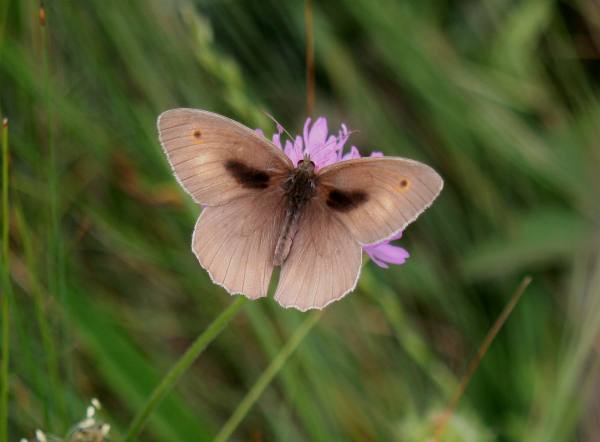Meadow Brown Butterfly - Maniola jurtina
Phylum: Arthropoda - Class: Insecta - Order: Lepidoptera - Family: Nymphalidae

A very common sight in wildflower meadows and other grassy places, this butterfly is seen on the wing throughout the summer and early autumn. Like other 'browns' the wings are often closed when at rest.

The fine specimen shown above is Maniola jurtina ssp hispulla, and it was photographed in the Algarve region of Portugal.
The extent of orange on the forewings is variable, as also is the number of black spots on the hindwing.

The wingspan ranges from 5 to 5.5cm, the male being slightly smaller than the females. Males and females are fairly similar; however the upperwings of the male have a smaller orange area and are usually a darker brown and more velvety than those of the female; however, the wings tend to fade with age, which can cause confusion. Females generally have a paler brown background to their upper wing surfaces. The black eyespot with its single white pupil is most clearly delineated in the female Meadow Brown, and this feature should prevent any confusion with the somewhat similar Gatekeeper, whose eyespot has a double pupil.
In common with other members of the Satyrinae (the so-called 'browns'), this butterfly walks using only four of its legs. The dark wing colouring helps absorb heat from sunlight, and so the wings warm up quickly; as a result you can often see Meadow Browns flying on days when it is so dull that most other butterflies remain grounded .
Distribution
The Meadow Brown is found throughout England, Wales and Ireland, and across Scotland save for some of the high mountainous areas. It is not reported from the Shetlands. Elsewhere this butterfly is common and widespread across most of Europe except the far north, and its range extends eastwards into Asia at least as far as Iran and southwards into the countries of North Africa.
Lifecycle
The larval foodplants of the Meadow Brown are various grasses, notably of Poa species such as Rough Meadow Grass, Poa trivialis, and Smooth Meadow Grass, Poa pratensis but also various fescues, Cocksfoot and oat grasses.
From eggs laid on or dropped among grasses, Meadow Brown larvae hatch in about two weeks, feeding on grass until the autumn, when they go in to hibernation low down in grass tussocks. On mild winter days the caterpillars sometimes emerge and resume feeding.
In March the green and slightly hairy caterpillars, each with a blackish dorsal stripe, waken fully from their hibernating state and begin feeding nocturnally once more, this time on the fresh spring growth of grass. The feeding rate is very variable - a genetic trait variation rather than a behavioural factor determined by food availability - so that some caterpillars reach maturity all through the summer and autumn.
After a pupation stage lasting about three weeks, the Meadow Brown butterflies emerge; they are short-lived and the females lay their eggs within the first four days of their 5 to 12-day adult lives.
Although producing only one generation per year, Meadow Browns can be usually seen flying from June until late September or occasionally into October. Thistles and nettles provide a welcome source of nectar for these common grassland butterflies.
Studying butterflies and moths...
Acknowledgements
This page includes pictures kindly contributed by Rob Petley-Jones.
Excited at the prospect of flyfishing? So are we, and we're pretty sure you would find the Winding River Mystery trilogy of action-packed thrillers gripping reading too. Dead Drift, Dead Cert, and Dead End are Pat O'Reilly's latest river-and-flyfishing based novels, and now they are available in ebook format. Full details on our website here...
Buy each book for just £4.96 on Amazon...
Please Help Us: If you have found this information interesting and useful, please consider helping to keep First Nature online by making a small donation towards the web hosting and internet costs.
Any donations over and above the essential running costs will help support the conservation work of Plantlife, the Rivers Trust and charitable botanic gardens - as do author royalties and publisher proceeds from books by Pat and Sue.
